Numerical Simulation of the 65Mn-Cr Steel Slab Solidification Process and Analysis of the Formation Mechanism of Internal Cracks
Abstract
1. Introduction
2. Mathematical Model
2.1. Model Assumptions
- (1)
- Ignore the radiation heat transfer between the surface of the molten steel and the surrounding environment and the heat transfer of the mold flux;
- (2)
- Ignore the vibration of the mold and the influence of the taper;
- (3)
- To simplify the calculation process, assume that the thermal conductivity of the solid-phase region of the casting blank is a function of temperature and the liquid-phase region is characterized by an equivalent thermal conductivity;
- (4)
- Assume that the flow and heat transfer of the molten steel during the continuous casting process reach a stable state and the same cooling section is uniformly cooled.
- (1)
- Assume that the internal medium of the casting blank is a continuous dense solid;
- (2)
- The solidification shrinkage deformation behavior of the casting blank meets the requirements of the small deformation theory, and the yield follows the von Mises criterion. The incremental relationship between stress and strain of the casting blank under plastic yield follows the Prandtl–Reuss flow incremental theory under the plastic potential correlation;
- (3)
- Ignore the influence of mechanical stress on the casting blank.
2.2. Control Equations
2.2.1. Flow and Heat Transfer Model
2.2.2. Stress Field Model
2.3. Simulation Process Parameters
2.4. Boundary Conditions
2.5. Physical Properties of 65Mn-Cr Steel
2.6. Model Verification
3. Results and Discussion
3.1. Results of Flow–Heat Transfer–Solidification Coupling Calculation
3.2. Stress–Strain Calculation Results During the Solidification Process
3.3. Experimental Results and Discussion
4. Conclusions
- (1)
- The solidification speeds of 65Mn-Cr steel slabs vary at different positions. Temperature rebounds occur at distances of 0.88 m, 1.45 m, and 3.2 m from the meniscus. Although the heat transfer rate from the solidification front to the surface of the slab slows down, differences in solidification speeds emerge at different positions. Moreover, due to the jet action of the submerged nozzle in the steel liquid, the flow field and temperature field distributions in the mold are non-uniform.
- (2)
- The stress distribution across the section of the 65Mn-Cr steel slab is non-uniform. The stress at the solidification front of the slab is mostly concentrated in the range of 2–6 MPa. Meanwhile, at the typical positions 1#, 2#, and 3# having a certain degree of section temperature non-uniformity, the solidification front is mainly affected by the combined action of stresses in the width and thickness directions, and the plastic strain value exceeds the critical strain of 0.004, making the steel prone to the quality problem of internal cracks.
- (3)
- The experimental results indicate that under the influence of the non-uniform distribution of the flow field and temperature field, crack defects appear within the shell thickness of 15–30 mm during the continuous casting production of 65Mn-Cr steel slabs. Therefore, on the premise of maintaining normal production, adjusting the spray distribution and cooling intensity of the spray water in the secondary cooling section to make it more coordinated with the flow field distribution of the steel liquid in the slab can effectively reduce the temperature difference at different positions of the slab, maintain the uniformity of the shell thickness, reduce the thermal stress at the solidification front, and decrease the occurrence of subcutaneous cracks.
Author Contributions
Funding
Institutional Review Board Statement
Informed Consent Statement
Data Availability Statement
Conflicts of Interest
References
- Yu, X.C.; Ni, X.H. Control Technology and Application of Central Segregation in Continuous Casting Slabs of Fine-blanking Steel in Meishan Steel. Spec. Steel 2019, 40, 28–30. [Google Scholar]
- Suzuki, H.G.; Nishimura, S.; Yamaguchi, S. Characteristics of hot ductility in steels subjected to the melting and solidification. Trans. Iron Steel Inst. Jpn. 1982, 22, 48. [Google Scholar] [CrossRef]
- Pradhan, N.; Banerjee, N.; Reddy, B.B.; Sahay, S.K.; Viswanathan, C.S.; Bhor, P.K.; Basu, D.S.; Mazumdar, S. Control of transverse cracking in special quality slabs. Ironmak. Steel Mak. 2001, 28, 305. [Google Scholar] [CrossRef]
- Ma, F.J.; Wen, G.H.; Tang, P.; Yu, X.; Li, J.Y.; Xu, G.D.; Mei, F. In situ observation and investigation of effect of cooling rate on slab surface microstructure evolution in micro alloyed steel. Ironmak. Steelmak. 2010, 37, 211. [Google Scholar] [CrossRef]
- Wang, H.; Chen, L.; Wang, X.H. Influence of Optimization of Mold and Secondary Cooling System on Subsurface Cracks of MnB Steel. Spec. Steel Technol. 2020, 26, 42–44. [Google Scholar]
- Zhou, S.G. Analysis of the Causes of Subsurface Cracks in the Corner of Bloom. Metall. Mater. 2022, 42, 130–132. [Google Scholar]
- Zou, L.L. Research on Solidification Characteristics and Crack Control of V-Nb-Ti Micro Alloyed Steel Continuous Casting Bloom; University of Science and Technology Beijing: Beijing, China, 2023. [Google Scholar]
- Guo, Q.S.; Wen, G.H.; Cheng, W.W. Causes of Subsurface Cracks in Gear Steel Rectangular Billet. J. Iron Steel Res. 2012, 24, 28. [Google Scholar]
- Yu, C.H.; Suzuki, M.; Shibata, H. Simulation of crack formation on solidifying steel shell in continuous casting mold. ISIJ Int. 1996, 36, S159. [Google Scholar] [CrossRef] [PubMed]
- Won, Y.M.; Kim, K.H.; Yeo, T.J. Effect of cooling rate on ZST, LIT and ZDT of carbon steels near melting point. ISIJ Int. 1998, 38, 1093. [Google Scholar] [CrossRef][Green Version]
- Seol, D.J.; Won, Y.M.; Oh, K.H. Mechanical behavior of carbon steels in the temperature range of mushy zone. ISIJ Int 2000, 40, 356. [Google Scholar] [CrossRef]
- Cornelissen, M.C.M. Mathematical model for solidification of multicomponent alloys. Ironmak. Steelmak. 1986, 13, 204. [Google Scholar]
- Yamanaka, A.; Nakajima, K.; Okamura, K. Critical strain for internal crack formation in continuous casting. Ironmak. Steelmak. 1995, 22, 508. [Google Scholar]
- Kobayashi, S. Relationships of fraction solid with zero ductility and zero strength temperatures during solidification. Testu-Hagane 1987, 73, S896. [Google Scholar]
- Han, Z.Q.; Cai, K.K. Review of the Conditions for the Formation of Internal Cracks in Continuous Casting Billets. J. Iron Steel Res. 2001, 41, 68–72. [Google Scholar]
- Yuan, W.X. Research on Strain and Internal Cracks during Solidification of Continuous Casting Billets. Steelmaking 2001, 17, 48. [Google Scholar]
- Qin, Y.; Liu, H.X.; Hu, Y.S. Causes and Control of Macro Defects in Continuous Casting Billets. Hebei Metall. 2004, 41, 35–43. [Google Scholar]
- Lin, P.; Zhang, H.C.; Xu, Z.Z. Analysis and Process Improvement of Subsurface Cracks in 55 Steel 150 mm × 150 mm Continuous Casting Billet. Spec. Steel 2020, 41, 43. [Google Scholar]
- Li, X.B. Quality Analysis and Finite Element Simulation of Continuous Casting and Rolling of Large-Specification GCr15 Bearing Steel. Ph.D. Thesis, Northeastern University, Shenyang, China, 2011. [Google Scholar]
- Li, Y.J.; Li, H. Thermo-elasto-visco-plastic finite element analysis on formation and propagation of off-corner subsurface cracks in bloom continuous casting. J. Iron Steel Res. Int. 2017, 24, 1159–1168. [Google Scholar] [CrossRef]
- Niu, Z.Y.; Cai, Z.Z. Formation Mechanism of a Wide-Face Longitudinal Off-Corner Depression During Thick Slab Continuous Casting. Metall. Mater. Trans. B 2021, 52, 2737. [Google Scholar] [CrossRef]
- Jones, W.P.; Launder, B.E. The calculation of low-reynolds-number phenomena with a two-equation model of turbulence. Int. J. Heat Mass Transf. 1973, 16, 1119. [Google Scholar] [CrossRef]
- Savage, J.; Pritchard, W.H. The problem of rupture of the billet in the continuous casting of steel. Iron Steel Inst. 1954, 178, 269–277. [Google Scholar]
- Wang, W. Numerical Simulation Analysis of the Influence of Carbon Composition on Heat Transfer and Stress During Slab Continuous Casting Under Soft Reduction. Master’s Thesis, Northeastern University, Shenyang, China, 2018. [Google Scholar]
- Dang, A.G.; Cui, J.; Li, Y.C. Generation and Control of Subsurface Cracks during Continuous Casting. J. Iron Steel Res. 2021, 33, 217–223. [Google Scholar]
- Qiu, H.; Shi, P.Z. Simulation of Continuous Casting Process of 250 mm × 1800 mm Slab with Different Submerged Nozzles. Foundry Technol. 2017, 38, 1701–1707. [Google Scholar]
- Dong, Q.; Zhang, J.; Yin, Y. Three-dimensional numerical modeling of macrosegregation in continuously cast billets. Metals 2017, 7, 209. [Google Scholar] [CrossRef]
- Cai, L.Q.; Wang, X.D. Meshless Method Modeling for Crack Initiation and Propagation of Continuous Casting Billets. Metall. Mater. Trans. B 2021, 52, 3302. [Google Scholar] [CrossRef]
- Swain, A.N.S.S.; Suvankar, G.; Arunava, S. Investigation of Corner Cracks in Continuous Casting Billet Using Thermomechanical Model and Plant Measurements. Met. Mater. Int. 2022, 28, 2434–2447. [Google Scholar] [CrossRef]
- Yang, B. Optimization of Soft Reduction Process at the End of Solidification of Bearing Steel Bloom and Control of Internal Quality of Casting Blank; Central Iron and Steel Research Institute: Beijing, China, 2023. [Google Scholar]
- Ma, H.T.; Zhang, J.M.; Yin, Y.B. Influence of Soft Reduction on the Sensitivity of Internal Cracks in Heavy Rail Steel Bloom. J. Eng. Sci. 2021, 43, 1679–1688. [Google Scholar]
- Lin, P.; Zhang, H.C.; Yin, C.L. Defect Analysis and Process Optimization of 45 Steel Casting Blank Containing Sulfur. Spec. Steel 2018, 39, 40–43. [Google Scholar]

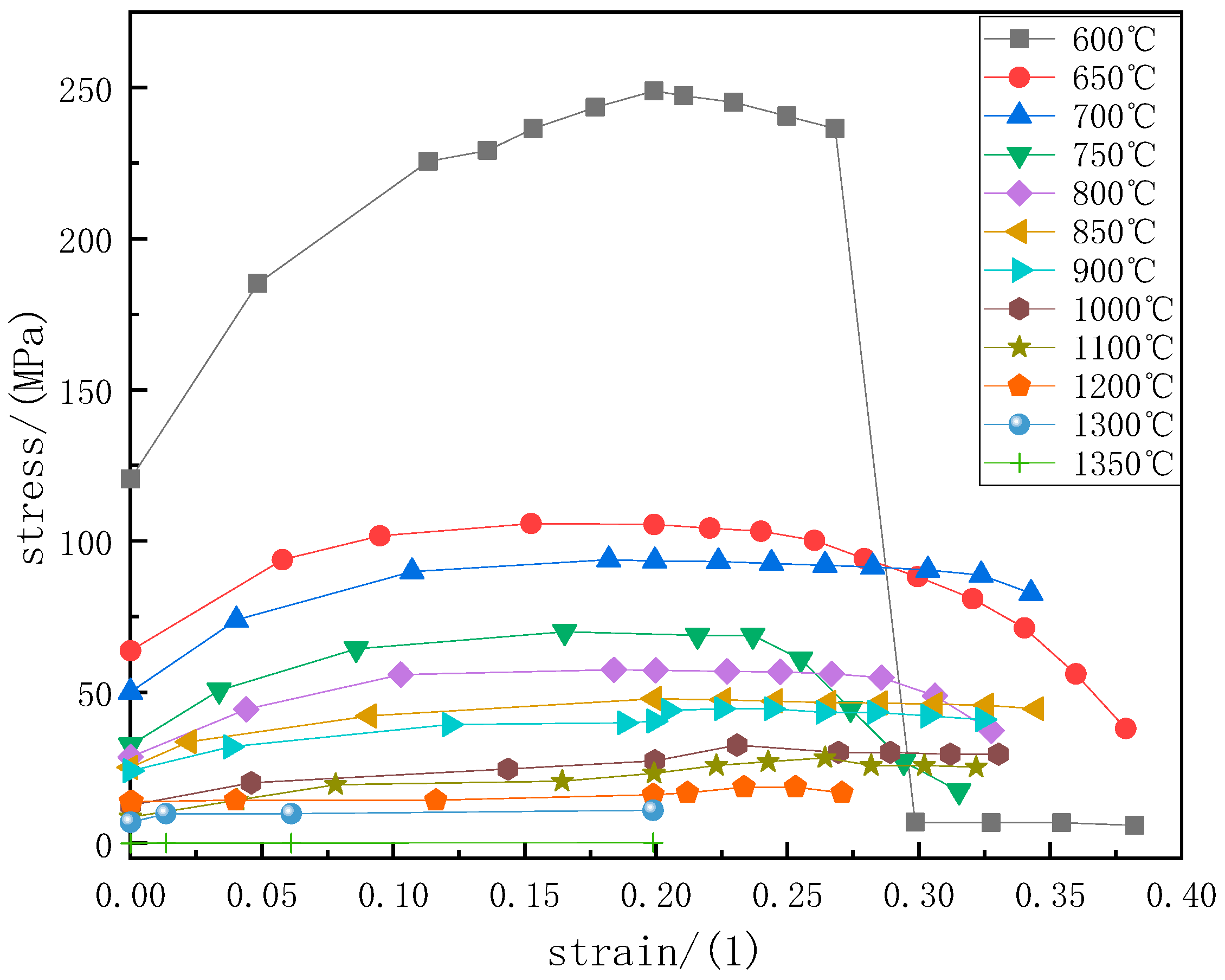
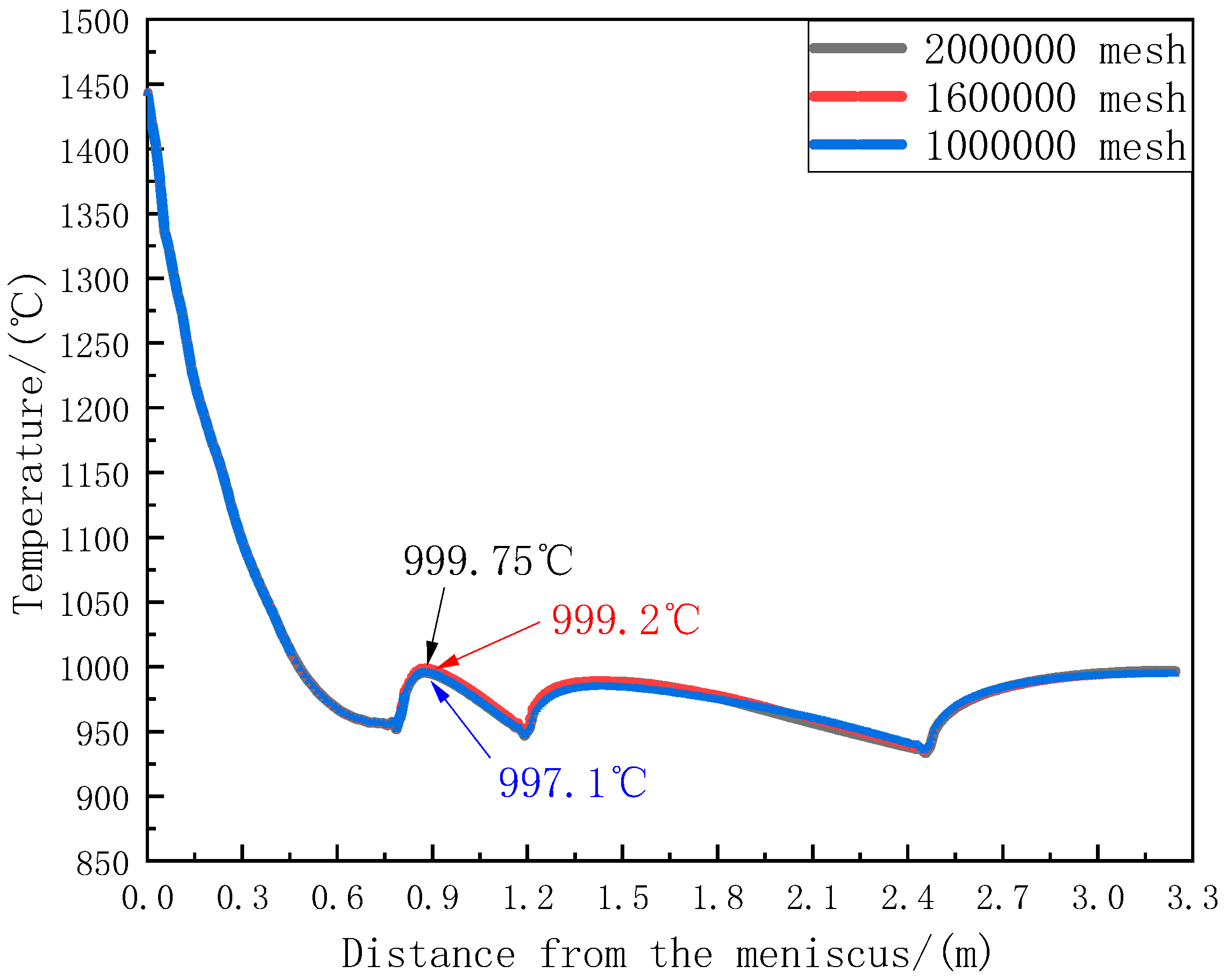
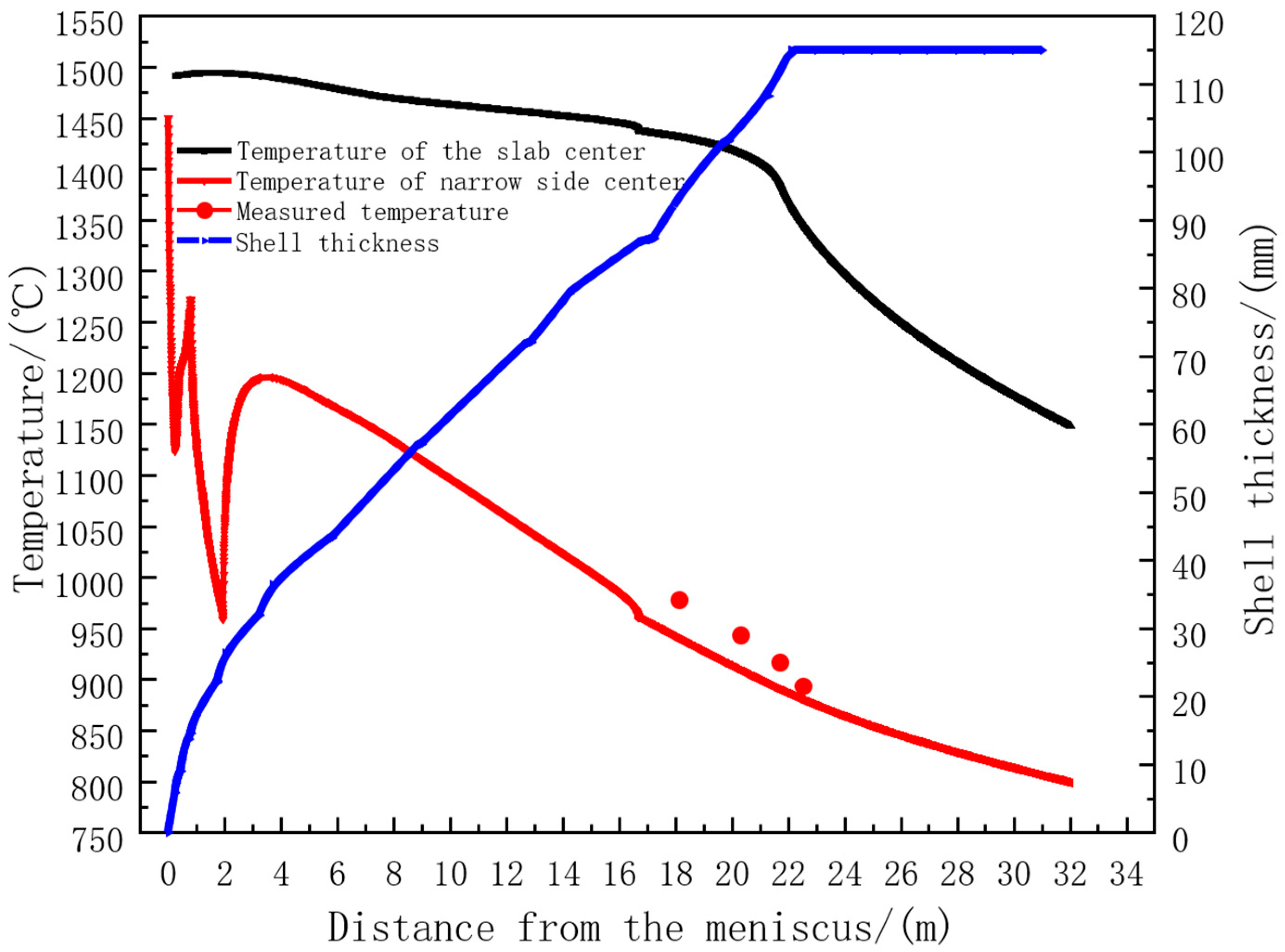
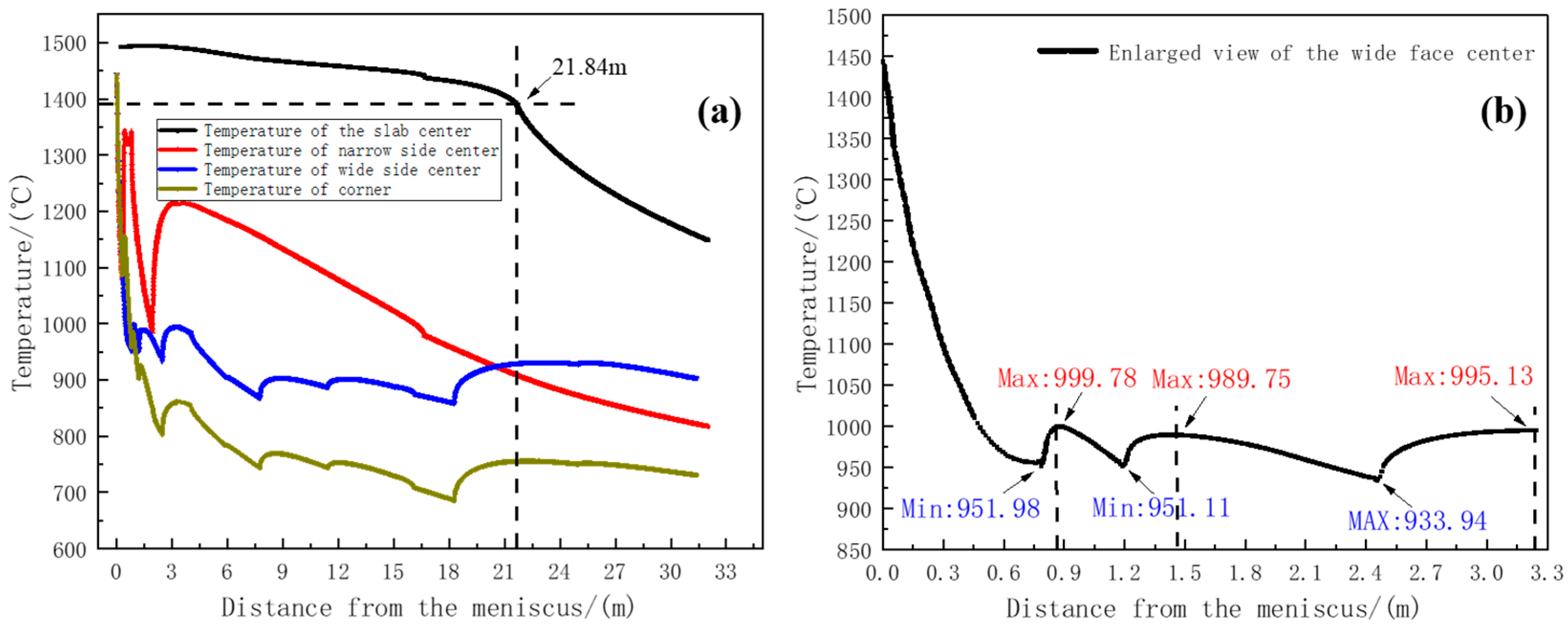
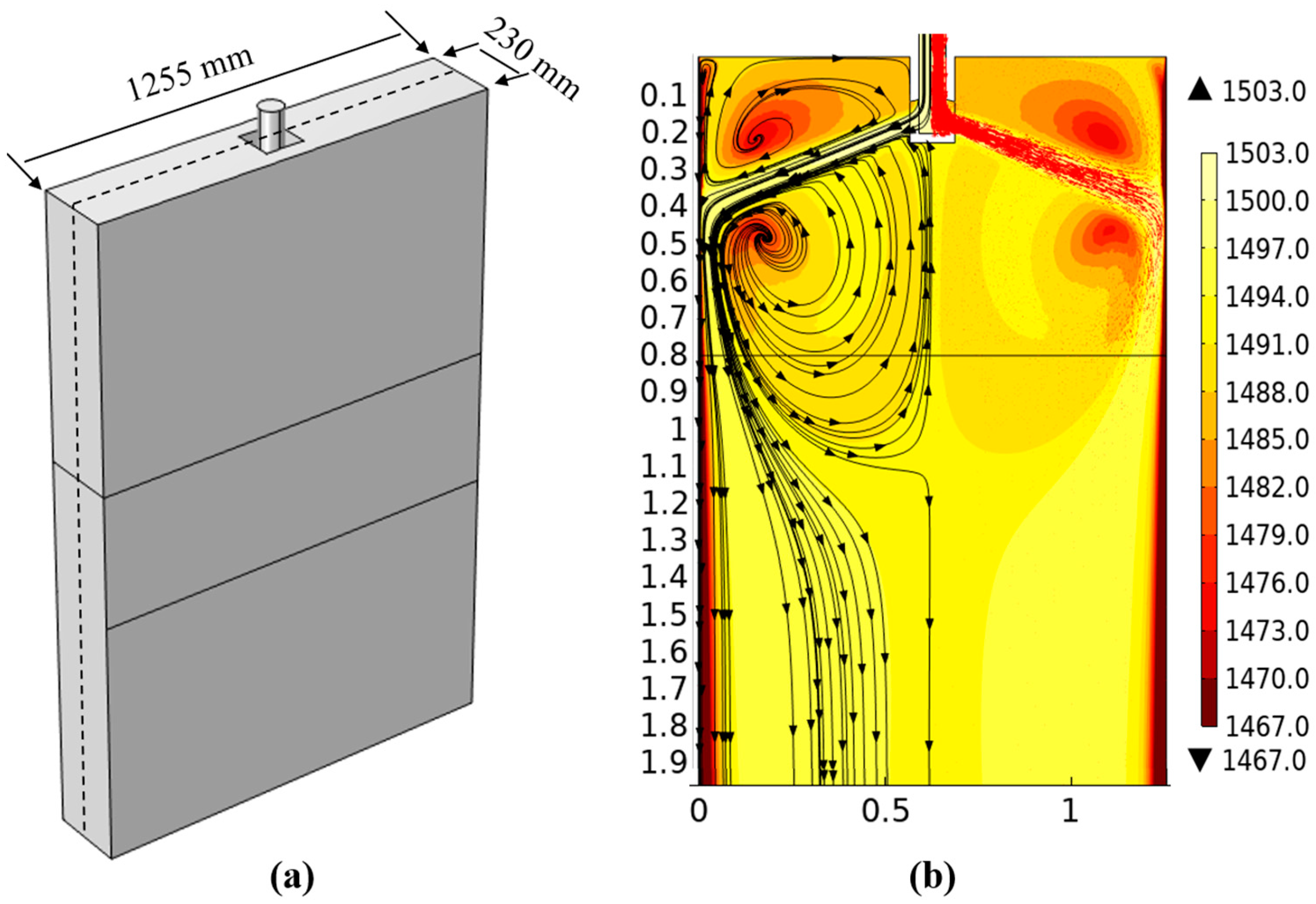


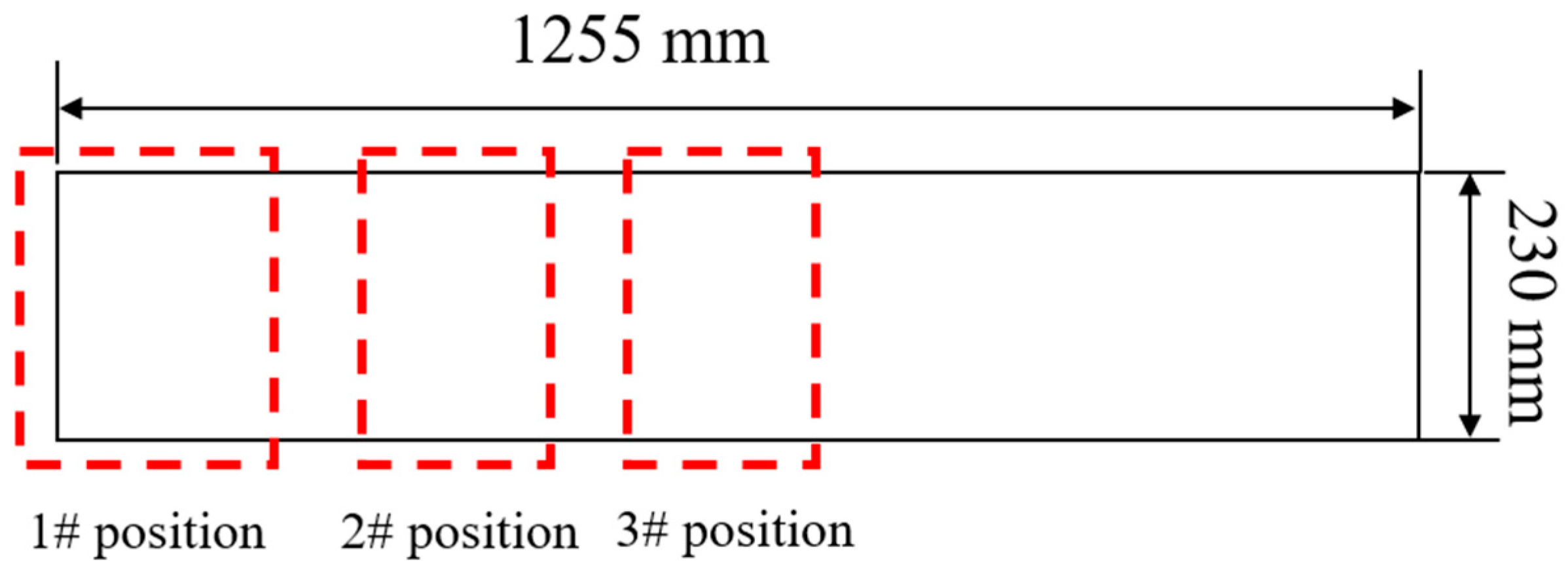


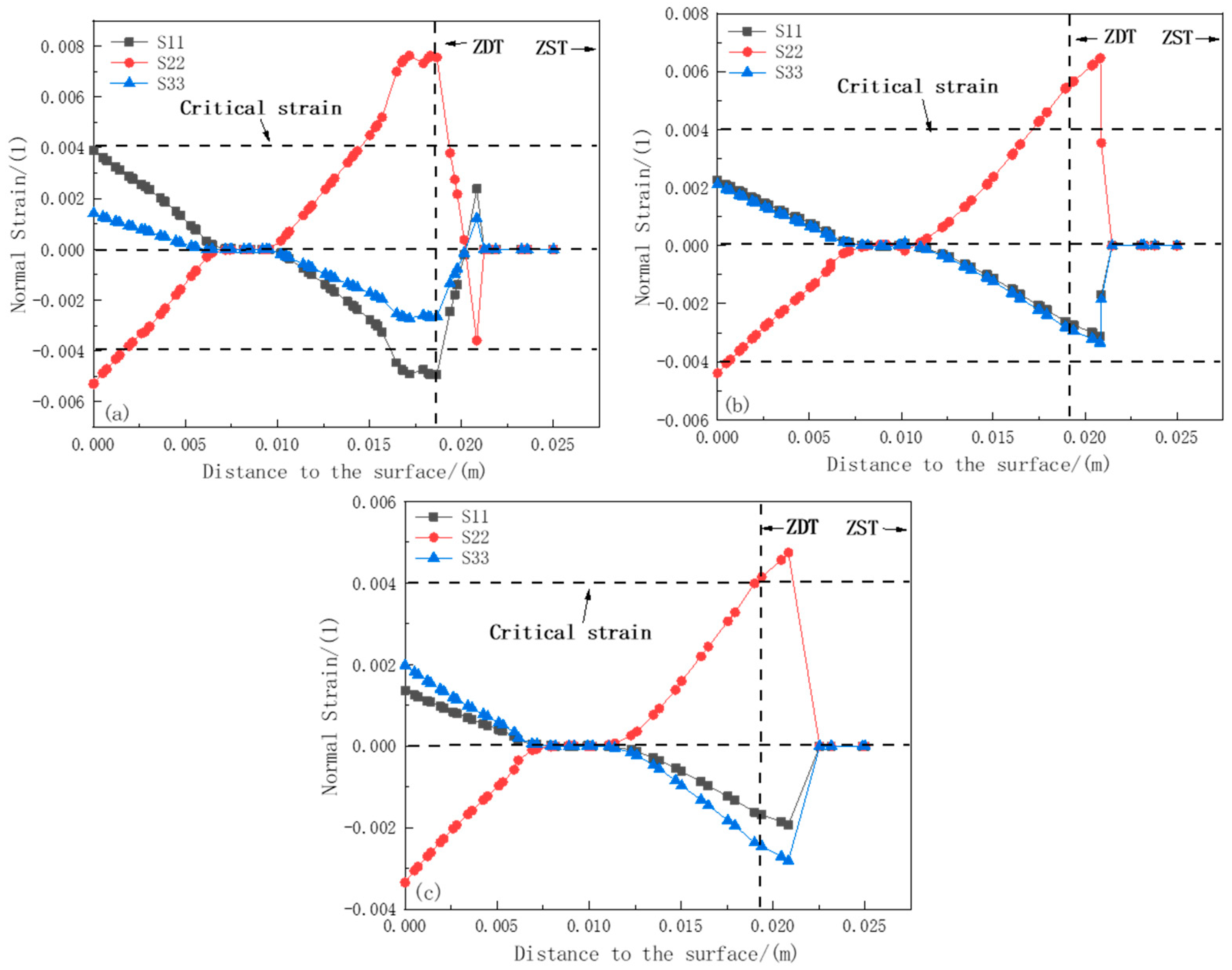

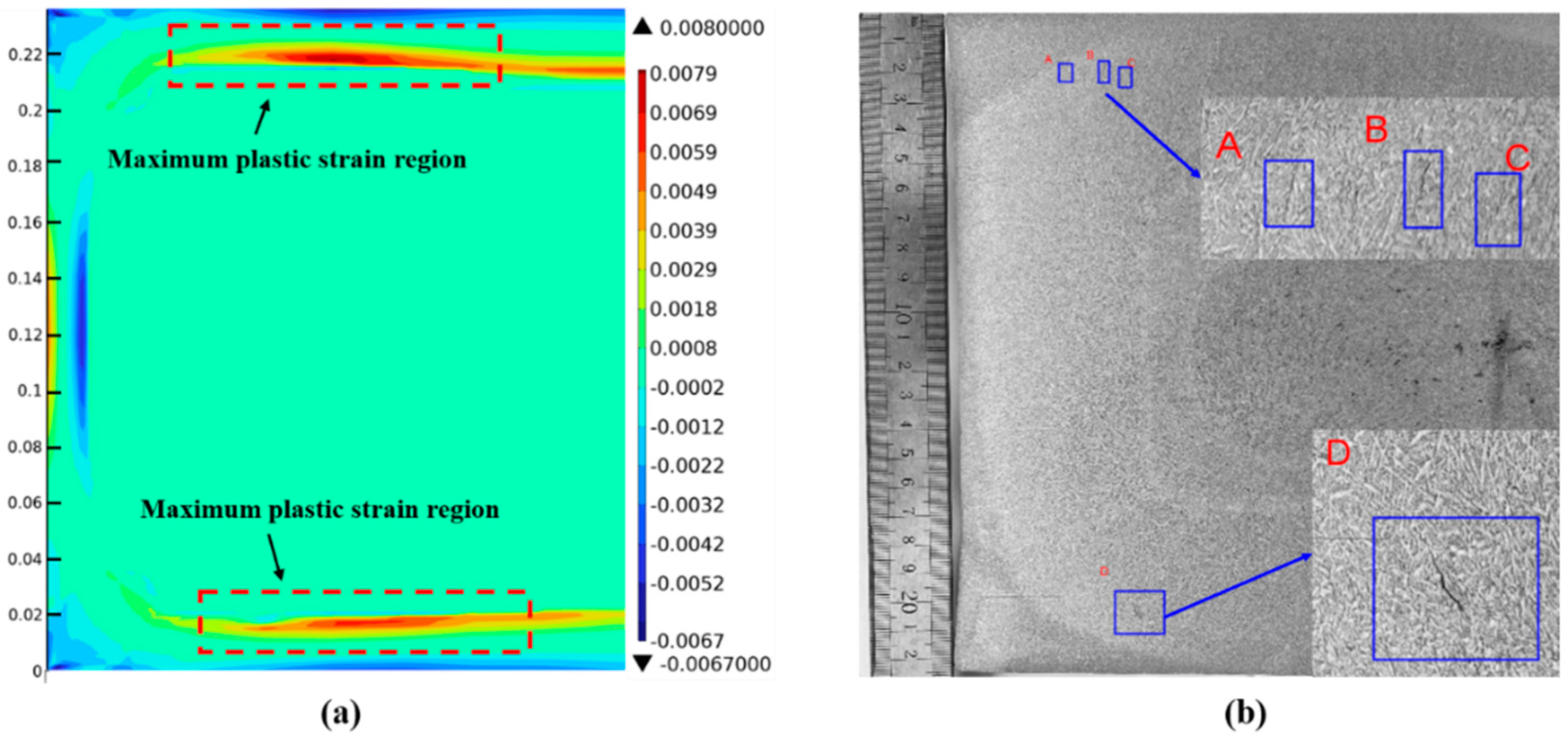
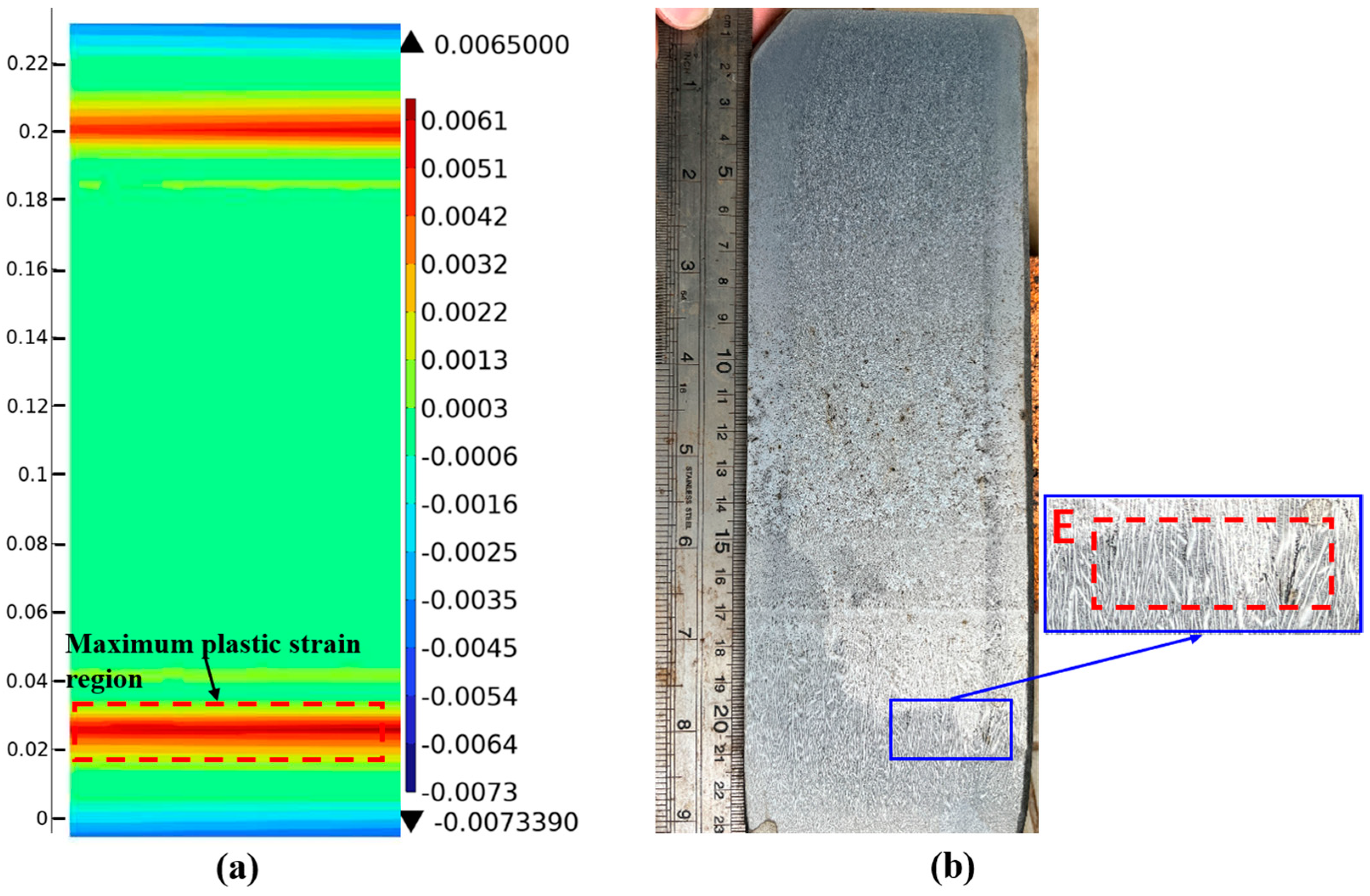

| Element | C | Mn | S | P | Si | Cr | Ni | Cu | Mo |
|---|---|---|---|---|---|---|---|---|---|
| Content | 0.64–0.68 | 0.95–1.1 | 0.01 | 0.02 | 0.2–0.37 | 0.13–0.22 | 0.3 | 0.25 | 0.1 |
| Parameter | Value |
|---|---|
| Casting blank section, mm × mm | 230 × 1255 |
| Casting speed, m·min−1 | 1.05 |
| Submerged nozzle immersion depth, mm | 120 |
| Pouring temperature, °C | 1503 |
| Wide-face inner-arc water flow rate, L·min−1 | 3794.5 |
| Wide-face outer-arc water flow rate, L·min−1 | 3785.1 |
| Narrow-face northward water flow rate, L·min−1 | 495.59 |
| Narrow-face southward water flow rate, L·min−1 | 496.53 |
| Wide-face inner-arc temperature difference, °C | 5.4 |
| Wide-face outer-arc temperature difference, °C | 5.1 |
| Narrow-face northward temperature difference, °C | 6.4 |
| Narrow-face southward temperature difference, °C | 6.2 |
| Liquidus temperature, °C | 1475 |
| Solidus temperature, °C | 1380 |
| Location | Calculated Temperature/°C | Measured Temperature/°C | Error |
|---|---|---|---|
| End of the 7th sector | 944.7 | 978 | 3.4% |
| End of the 8th sector | 912.8 | 943.3 | 3.2% |
| Middle of the 9th sector | 898.4 | 916.6 | 1.99% |
| End of the 9th sector | 884.7 | 893.4 | 0.97% |
| Continuous Casting Machine Zone | Zone 1 | Zone 2 | Zone 3 | Zone 4 | Zone 5 |
|---|---|---|---|---|---|
| Heat Rebound Temperature/°C | 46.8 | 38.64 | 61.19 | 0.92 | 0 |
| Heat Rebound Rate/(°C·m−1) | 118.05 | 153.94 | 76.48 | 11.02 | 0 |
Disclaimer/Publisher’s Note: The statements, opinions and data contained in all publications are solely those of the individual author(s) and contributor(s) and not of MDPI and/or the editor(s). MDPI and/or the editor(s) disclaim responsibility for any injury to people or property resulting from any ideas, methods, instructions or products referred to in the content. |
© 2025 by the authors. Licensee MDPI, Basel, Switzerland. This article is an open access article distributed under the terms and conditions of the Creative Commons Attribution (CC BY) license (https://creativecommons.org/licenses/by/4.0/).
Share and Cite
Zhang, L.; Xu, L.; Zhang, G.; Zhang, H.; Jiang, Q.; Yin, S. Numerical Simulation of the 65Mn-Cr Steel Slab Solidification Process and Analysis of the Formation Mechanism of Internal Cracks. Materials 2025, 18, 872. https://doi.org/10.3390/ma18040872
Zhang L, Xu L, Zhang G, Zhang H, Jiang Q, Yin S. Numerical Simulation of the 65Mn-Cr Steel Slab Solidification Process and Analysis of the Formation Mechanism of Internal Cracks. Materials. 2025; 18(4):872. https://doi.org/10.3390/ma18040872
Chicago/Turabian StyleZhang, Li, Lijun Xu, Guifang Zhang, Haibo Zhang, Qi Jiang, and Shubiao Yin. 2025. "Numerical Simulation of the 65Mn-Cr Steel Slab Solidification Process and Analysis of the Formation Mechanism of Internal Cracks" Materials 18, no. 4: 872. https://doi.org/10.3390/ma18040872
APA StyleZhang, L., Xu, L., Zhang, G., Zhang, H., Jiang, Q., & Yin, S. (2025). Numerical Simulation of the 65Mn-Cr Steel Slab Solidification Process and Analysis of the Formation Mechanism of Internal Cracks. Materials, 18(4), 872. https://doi.org/10.3390/ma18040872







